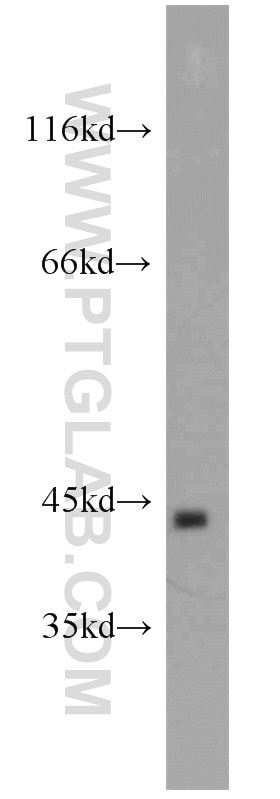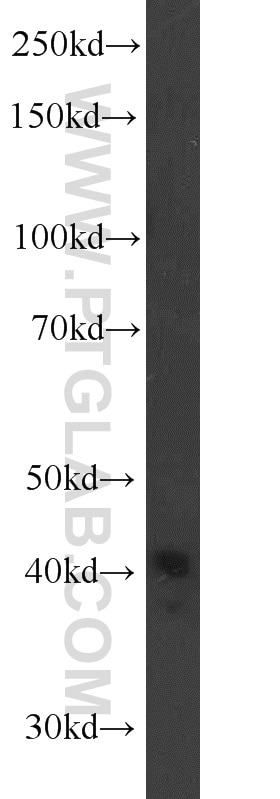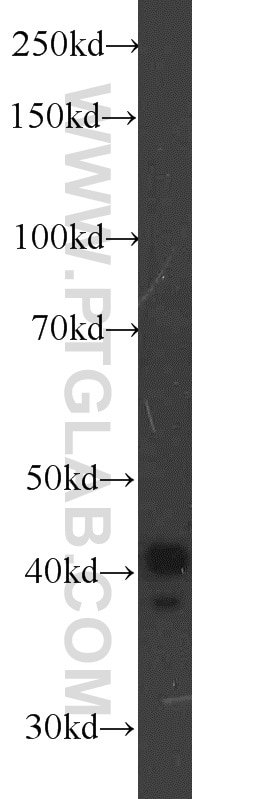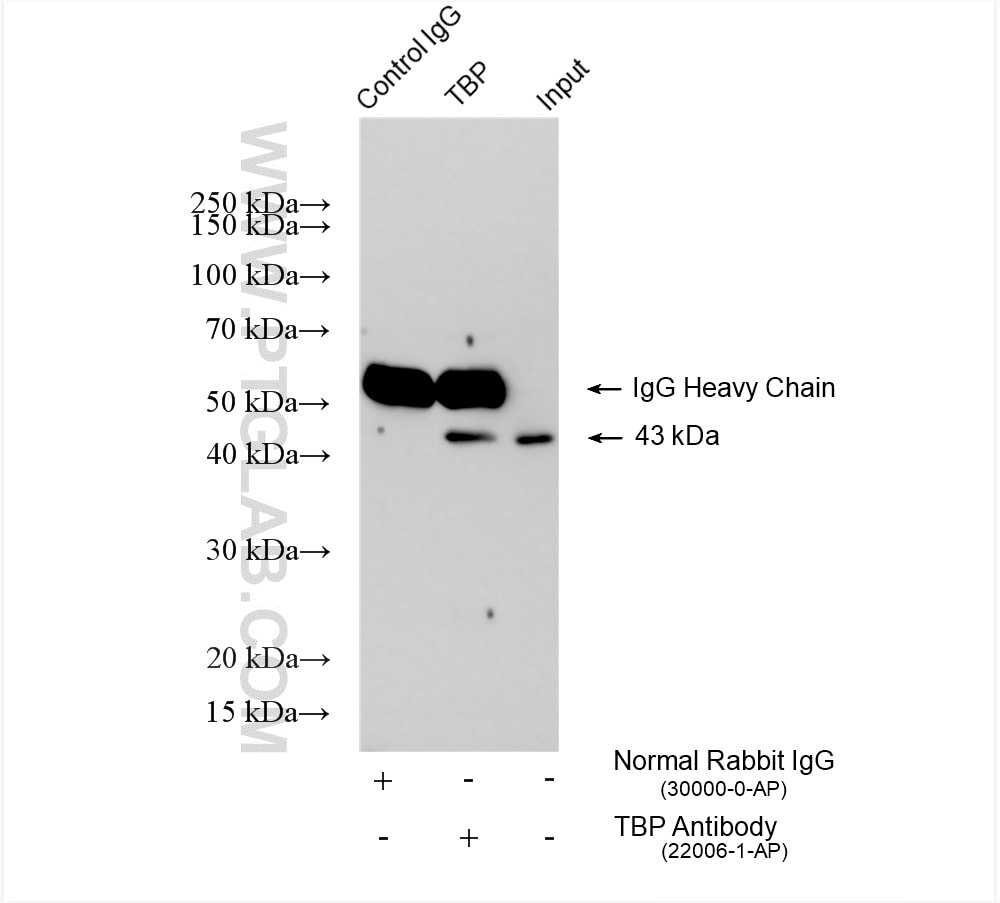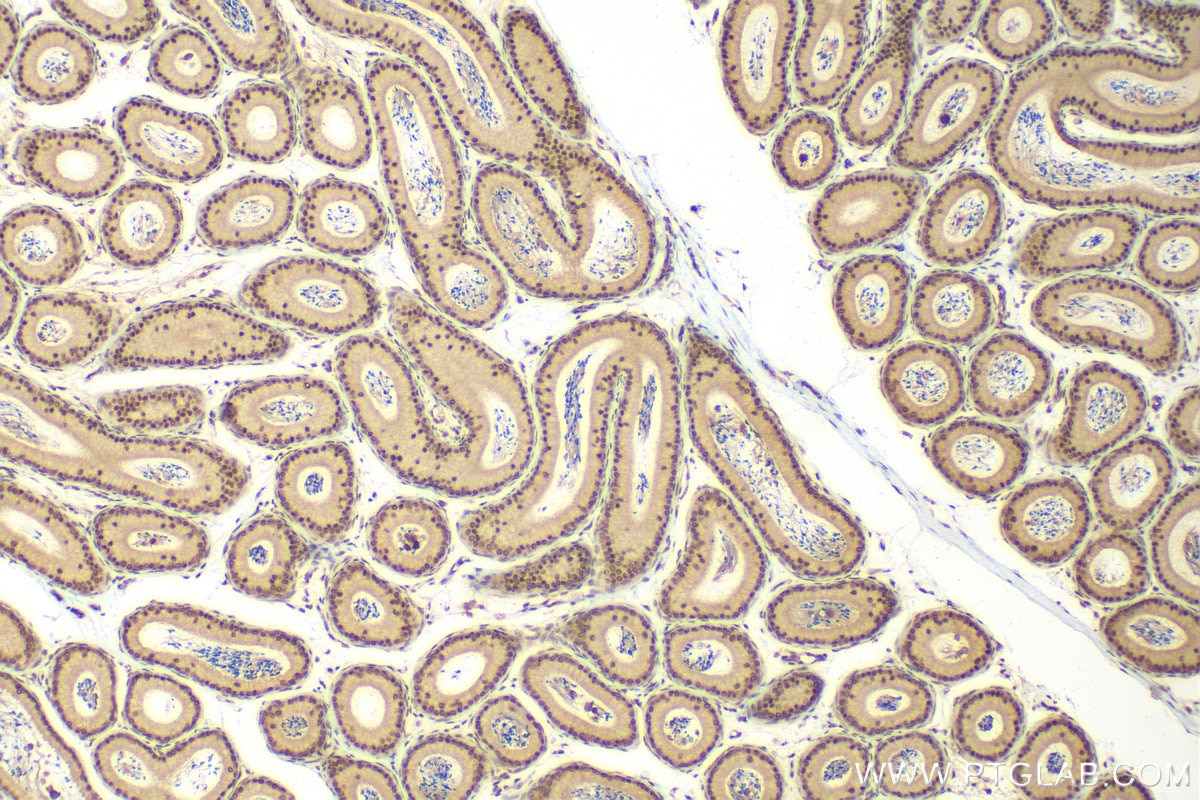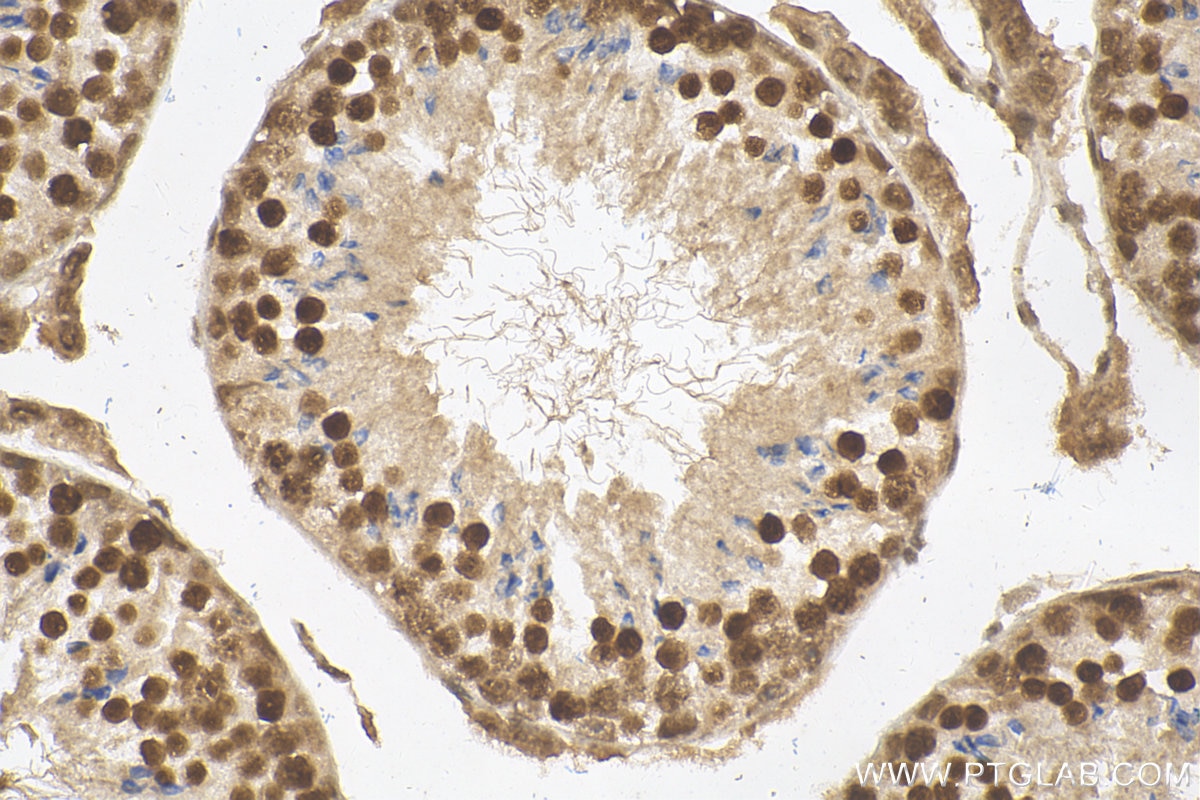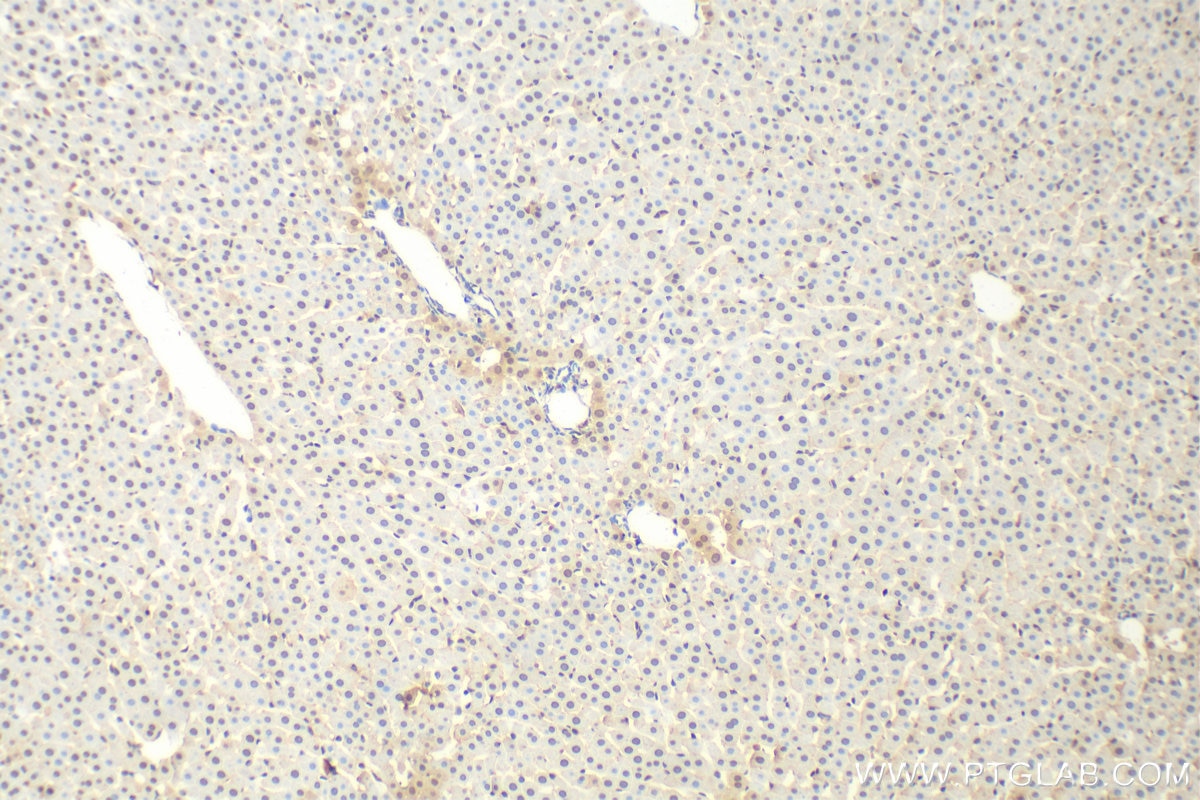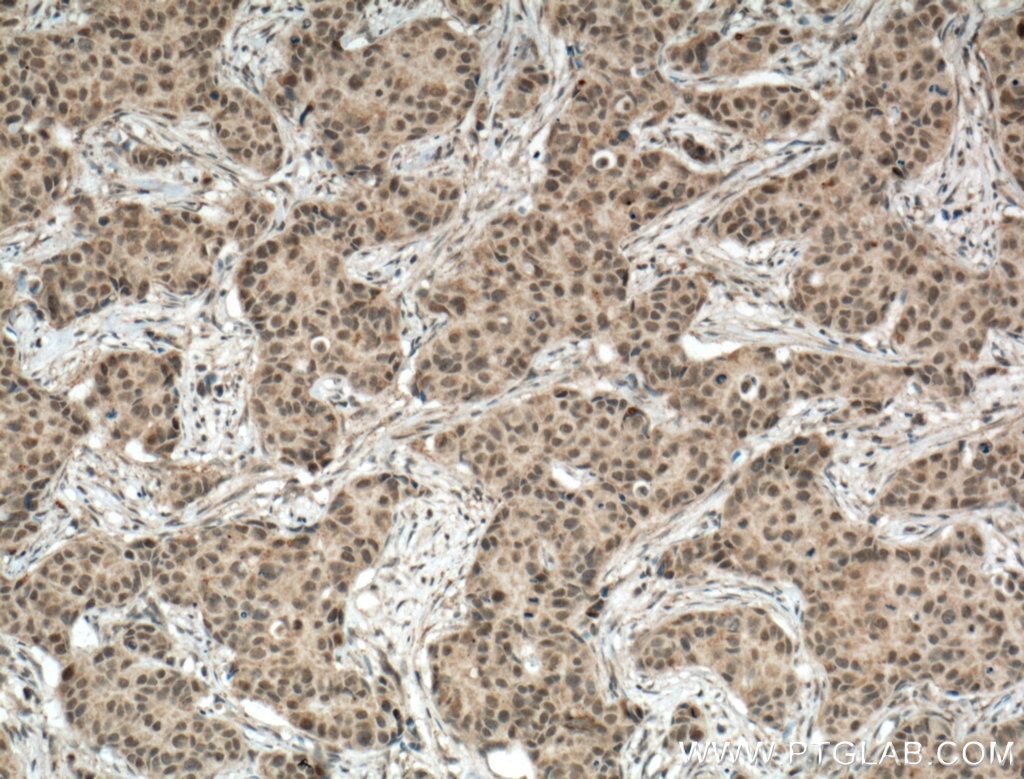Anticorps Polyclonal de lapin anti-TBP
TBP Polyclonal Antibody for WB, IP, IHC, ELISA
Hôte / Isotype
Lapin / IgG
Réactivité testée
Humain, rat, souris et plus (2)
Applications
WB, IHC, IF, IP, ChIP, ELISA
Conjugaison
Non conjugué
N° de cat : 22006-1-AP
Synonymes
"TBP Antibodies" Comparison
View side-by-side comparison of TBP antibodies from other vendors to find the one that best suits your research needs.
Applications testées
| Résultats positifs en WB | cellules COLO 320 |
| Résultats positifs en IP | cellules COLO 320 |
| Résultats positifs en IHC | tissu testiculaire de souris, tissu de cancer du sein humain, tissu hépatique de rat il est suggéré de démasquer l'antigène avec un tampon de TE buffer pH 9.0; (*) À défaut, 'le démasquage de l'antigène peut être 'effectué avec un tampon citrate pH 6,0. |
Dilution recommandée
| Application | Dilution |
|---|---|
| Western Blot (WB) | WB : 1:500-1:3000 |
| Immunoprécipitation (IP) | IP : 0.5-4.0 ug for 1.0-3.0 mg of total protein lysate |
| Immunohistochimie (IHC) | IHC : 1:250-1:1000 |
| It is recommended that this reagent should be titrated in each testing system to obtain optimal results. | |
| Sample-dependent, check data in validation data gallery | |
Applications publiées
| WB | See 79 publications below |
| IHC | See 1 publications below |
| IF | See 3 publications below |
| IP | See 3 publications below |
| ChIP | See 1 publications below |
Informations sur le produit
22006-1-AP cible TBP dans les applications de WB, IHC, IF, IP, ChIP, ELISA et montre une réactivité avec des échantillons Humain, rat, souris
| Réactivité | Humain, rat, souris |
| Réactivité citée | rat, Humain, porc, singe, souris |
| Hôte / Isotype | Lapin / IgG |
| Clonalité | Polyclonal |
| Type | Anticorps |
| Immunogène | TBP Protéine recombinante Ag12383 |
| Nom complet | TATA box binding protein |
| Masse moléculaire calculée | 338 aa, 38 kDa |
| Poids moléculaire observé | mouse/rat 33-36 kDa and human 37-43kDa |
| Numéro d’acquisition GenBank | BC110341 |
| Symbole du gène | TBP |
| Identification du gène (NCBI) | 6908 |
| Conjugaison | Non conjugué |
| Forme | Liquide |
| Méthode de purification | Purification par affinité contre l'antigène |
| Tampon de stockage | PBS with 0.02% sodium azide and 50% glycerol |
| Conditions de stockage | Stocker à -20°C. Stable pendant un an après l'expédition. L'aliquotage n'est pas nécessaire pour le stockage à -20oC Les 20ul contiennent 0,1% de BSA. |
Informations générales
The TATA binding protein (TBP) is a transcription factor that binds specifically to a DNA sequence TATA box. This DNA sequence is found about 25-30 base pairs upstream of the transcription start site in some eukaryotic gene promoters. TBP, along with a variety of TBP-associated factors, make up the TFIID, a general transcription factor that in turn makes up part of the RNA polymerase II preinitiation complex. As one of the few proteins in the preinitation complex that binds DNA in a sequence-specific manner, it helps position RNA polymerase II over the transcription start site of the gene. However, it is estimated that only 10-20% of human promoters have TATA boxes. Therefore, TBP is probably not the only protein involved in positioning RNA polymerase II. This antibody recognize human TBP with MW 40 kDa and mouse/rat Tbp with MW 34 kDa.
Protocole
| Product Specific Protocols | |
|---|---|
| WB protocol for TBP antibody 22006-1-AP | Download protocol |
| IHC protocol for TBP antibody 22006-1-AP | Download protocol |
| IP protocol for TBP antibody 22006-1-AP | Download protocol |
| Standard Protocols | |
|---|---|
| Click here to view our Standard Protocols |
Publications
| Species | Application | Title |
|---|---|---|
Hepatology Steatotic hepatocytes release mature VLDL via methionine and tyrosine metabolism in a Keap1-Nrf2 dependent manner. | ||
Redox Biol Dysfunction of astrocytic glycophagy exacerbates reperfusion injury in ischemic stroke | ||
Cancer Res DNA of neutrophil extracellular traps binds TMCO6 to impair CD8+ T-cell immunity in hepatocellular carcinoma | ||
J Hazard Mater ZnO NPs delay the recovery of psoriasis-like skin lesions through promoting nuclear translocation of p-NFκB p65 and cysteine deficiency in keratinocytes. |
Avis
The reviews below have been submitted by verified Proteintech customers who received an incentive for providing their feedback.
FH Mi (Verified Customer) (06-25-2023) | This antibody works very well in human white and brown adipocyte cells.
|
